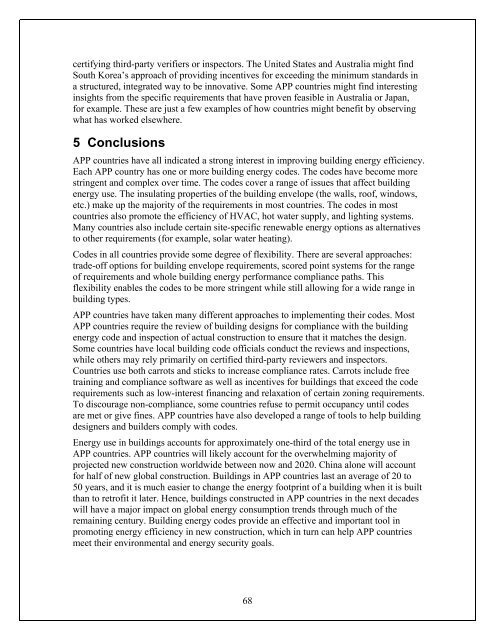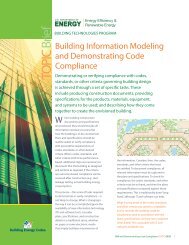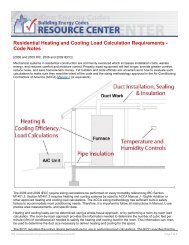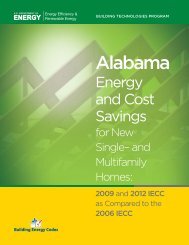Shaping the Energy Efficiency in New Buildings - Building Energy ...
Shaping the Energy Efficiency in New Buildings - Building Energy ...
Shaping the Energy Efficiency in New Buildings - Building Energy ...
You also want an ePaper? Increase the reach of your titles
YUMPU automatically turns print PDFs into web optimized ePapers that Google loves.
certify<strong>in</strong>g third-party verifiers or <strong>in</strong>spectors. The United States and Australia might f<strong>in</strong>dSouth Korea’s approach of provid<strong>in</strong>g <strong>in</strong>centives for exceed<strong>in</strong>g <strong>the</strong> m<strong>in</strong>imum standards <strong>in</strong>a structured, <strong>in</strong>tegrated way to be <strong>in</strong>novative. Some APP countries might f<strong>in</strong>d <strong>in</strong>terest<strong>in</strong>g<strong>in</strong>sights from <strong>the</strong> specific requirements that have proven feasible <strong>in</strong> Australia or Japan,for example. These are just a few examples of how countries might benefit by observ<strong>in</strong>gwhat has worked elsewhere.5 ConclusionsAPP countries have all <strong>in</strong>dicated a strong <strong>in</strong>terest <strong>in</strong> improv<strong>in</strong>g build<strong>in</strong>g energy efficiency.Each APP country has one or more build<strong>in</strong>g energy codes. The codes have become morestr<strong>in</strong>gent and complex over time. The codes cover a range of issues that affect build<strong>in</strong>genergy use. The <strong>in</strong>sulat<strong>in</strong>g properties of <strong>the</strong> build<strong>in</strong>g envelope (<strong>the</strong> walls, roof, w<strong>in</strong>dows,etc.) make up <strong>the</strong> majority of <strong>the</strong> requirements <strong>in</strong> most countries. The codes <strong>in</strong> mostcountries also promote <strong>the</strong> efficiency of HVAC, hot water supply, and light<strong>in</strong>g systems.Many countries also <strong>in</strong>clude certa<strong>in</strong> site-specific renewable energy options as alternativesto o<strong>the</strong>r requirements (for example, solar water heat<strong>in</strong>g).Codes <strong>in</strong> all countries provide some degree of flexibility. There are several approaches:trade-off options for build<strong>in</strong>g envelope requirements, scored po<strong>in</strong>t systems for <strong>the</strong> rangeof requirements and whole build<strong>in</strong>g energy performance compliance paths. Thisflexibility enables <strong>the</strong> codes to be more str<strong>in</strong>gent while still allow<strong>in</strong>g for a wide range <strong>in</strong>build<strong>in</strong>g types.APP countries have taken many different approaches to implement<strong>in</strong>g <strong>the</strong>ir codes. MostAPP countries require <strong>the</strong> review of build<strong>in</strong>g designs for compliance with <strong>the</strong> build<strong>in</strong>genergy code and <strong>in</strong>spection of actual construction to ensure that it matches <strong>the</strong> design.Some countries have local build<strong>in</strong>g code officials conduct <strong>the</strong> reviews and <strong>in</strong>spections,while o<strong>the</strong>rs may rely primarily on certified third-party reviewers and <strong>in</strong>spectors.Countries use both carrots and sticks to <strong>in</strong>crease compliance rates. Carrots <strong>in</strong>clude freetra<strong>in</strong><strong>in</strong>g and compliance software as well as <strong>in</strong>centives for build<strong>in</strong>gs that exceed <strong>the</strong> coderequirements such as low-<strong>in</strong>terest f<strong>in</strong>anc<strong>in</strong>g and relaxation of certa<strong>in</strong> zon<strong>in</strong>g requirements.To discourage non-compliance, some countries refuse to permit occupancy until codesare met or give f<strong>in</strong>es. APP countries have also developed a range of tools to help build<strong>in</strong>gdesigners and builders comply with codes.<strong>Energy</strong> use <strong>in</strong> build<strong>in</strong>gs accounts for approximately one-third of <strong>the</strong> total energy use <strong>in</strong>APP countries. APP countries will likely account for <strong>the</strong> overwhelm<strong>in</strong>g majority ofprojected new construction worldwide between now and 2020. Ch<strong>in</strong>a alone will accountfor half of new global construction. Build<strong>in</strong>gs <strong>in</strong> APP countries last an average of 20 to50 years, and it is much easier to change <strong>the</strong> energy footpr<strong>in</strong>t of a build<strong>in</strong>g when it is builtthan to retrofit it later. Hence, build<strong>in</strong>gs constructed <strong>in</strong> APP countries <strong>in</strong> <strong>the</strong> next decadeswill have a major impact on global energy consumption trends through much of <strong>the</strong>rema<strong>in</strong><strong>in</strong>g century. Build<strong>in</strong>g energy codes provide an effective and important tool <strong>in</strong>promot<strong>in</strong>g energy efficiency <strong>in</strong> new construction, which <strong>in</strong> turn can help APP countriesmeet <strong>the</strong>ir environmental and energy security goals.68
















